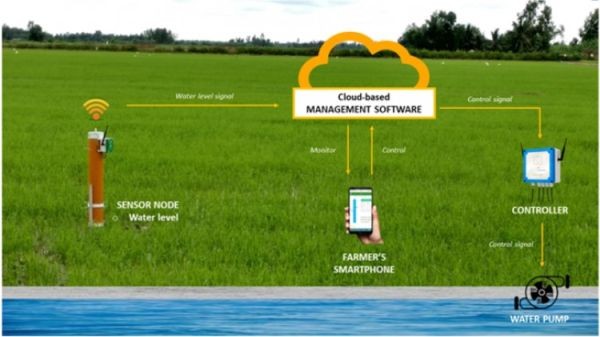No products in the cart.
NEWS
Revolutionizing Rice Farming: How IoT and Smart Irrigation are Saving Water
As an expert in sustainable agriculture, both in cultivating crops and raising livestock, I’ve seen firsthand how technology is transforming the way we farm. The pressing challenges of climate change and resource scarcity, particularly water, demand innovative solutions. One exciting development is the application of the Internet of Things (IoT) in irrigation, dramatically improving efficiency, especially in water-intensive crops like rice.
Recently, I’ve been following a pilot project in Vietnam, where a leading university collaborated with a tech company to test an advanced irrigation technique known as Intermittent Wetting and Drying (AWD), managed by an IoT system. The results are truly promising: this approach reduced water consumption by 13-20% compared to traditional methods. This isn’t just a small tweak; it’s a significant step towards more sustainable and resilient farming practices.
Understanding the Smart Irrigation System
So, how does this clever system work? It’s built on a simple yet powerful concept: giving the plant water only when and where it needs it, guided by real-time data.
The core components include:
- Sensors: Placed in the rice fields, these sensors constantly measure the water level (or soil moisture).
- Data Transmission: The sensor data is automatically sent to management software connected to a cloud infrastructure.
- Analysis and Recommendation: The software analyzes the real-time data and compares it against optimal conditions for the crop stage. It then generates recommendations for when and how much to water.
- User Interface: Farmers can access all this information and the recommendations through a user-friendly smartphone application. This allows them to see the actual field conditions and the suggested actions.
- Pump Control: Based on the recommendations and their decision, farmers can operate the water pumps remotely via the app or manually.
This creates a feedback loop that ensures precise water delivery, moving away from scheduled or flood irrigation to data-driven, on-demand watering.
 Diagram showing the architecture of an IoT system for smart agricultural irrigation, connecting sensors to cloud management and mobile control.
Diagram showing the architecture of an IoT system for smart agricultural irrigation, connecting sensors to cloud management and mobile control.
Why Smart Irrigation Matters, Especially in Challenging Climates
The impact of systems like this is particularly crucial in regions facing increasing water stress, such as the Mekong Delta, which has experienced severe, prolonged droughts in recent years. Fresh water is becoming a precious commodity.
“Adopting precise irrigation technologies like AWD powered by IoT is no longer just an option, it’s becoming a necessity for food security and environmental sustainability,” notes Dr. Thanh Hoang, an agricultural water management specialist. “Saving 15-20% of water per crop cycle adds up to enormous volumes over a large area, directly impacting water availability for other uses and improving resilience against drought.”
Beyond water savings, the system offers high reliability, operating with near 100% uptime in the pilot. It provides continuous accuracy in measuring water levels. While minor issues like power outages or maintenance occurred, they were infrequent and didn’t significantly disrupt operations. Farmers involved in the project praised the system’s ease of use, accuracy, and convenience.
The Future of Farming is Connected
This pilot project, supported by international collaboration, demonstrates the tangible benefits of integrating technology into traditional farming practices. It’s a clear example of how precision agriculture can lead to greater efficiency, resource conservation, and improved resilience against environmental challenges.
Embracing these kinds of smart farming solutions helps cultivate not just healthier crops, but a healthier planet. At Biogarden.Asia, we believe in empowering farmers and gardeners with the best tools and knowledge available to grow sustainably. While this specific IoT system showcases advanced field-scale technology, the principles of monitoring, data-driven decision-making, and efficient resource use are applicable at all levels of agriculture. We are continuously exploring and offering products that align with this vision of a more intelligent and sustainable approach to cultivation.
Have you experimented with smart tools or techniques to save water in your garden or farm? Share your experiences below!



